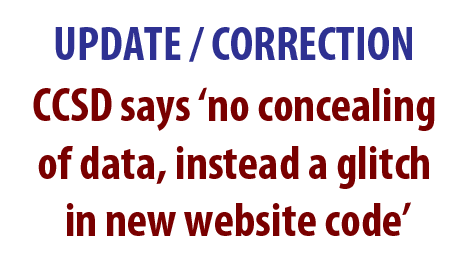 LAS VEGAS — The Clark County School District says what appeared to be the loss of previously reported financial data on the district’s online “Open Book” web tool was really only a glitch inadvertently introduced into the site by programmers seeking to modify it for Ipad users.
LAS VEGAS — The Clark County School District says what appeared to be the loss of previously reported financial data on the district’s online “Open Book” web tool was really only a glitch inadvertently introduced into the site by programmers seeking to modify it for Ipad users.
Nevada Journal published a story Thursday afternoon reporting on the apparently inaccessible data and noting that line-item information referenced by the Journal in recent stories — such as the district’s spending on outside legal counsel — no longer appeared when a user clicked on the relevant budget heading.
That Thursday story, however, conclusively stated that “the state’s largest school district has moved to conceal budgetary line items from the public on its online ‘Open Book’ tool.”
Nevada Journal retracts that allegation and apologizes. We were in error in too-hastily publishing that report, and also in concluding — based on past experience — that the change in the website’s accessibility resulted from an intentional decision made within the school district to keep information from the public.
So what happened?
It is true that, for weeks, individuals seeking to access the line-item detail information had found themselves presented with a detail section that appeared frozen and inaccessible.
Having noticed the change, Nevada Journal Reporter Karen Gray had, at 2:44 p.m. Wednesday, submitted several questions to, and requested comment from, Kirsten Searer, CCSD’s chief of staff and external relations.
As the designated contact assigned by the district to Nevada Journal, and as supervisor of the CCSD communications office, Searer was asked to respond to the issues the story was about to raise.
In two different emails that afternoon, Gray asked Searer about “the removal of sub-category budget line items” and the “omissions of employee position lines.”
Gray also asked, “Why was the tool modified? Does the new version increase transparency? And, if so, where and how?
“An explanation on that would be great,” she added.
Gray also informed Searer that the Journal’s deadline for any responses would be 10 a.m. the following day, Thursday.
That deadline had been set by this editor.
At 4:48 p.m., Gray received a read-receipt from Searer’s email application, indicating that one of the emails sent to the district’s external-relations chief had been opened.
However, no actual comment, explanation or response from Searer was then forthcoming.
At 11:16 that evening, still having heard nothing from the district’s communications officer, Gray decided to reach out to CCSD Board President Erin Cranor.
Gray forwarded to Cranor the full length email thread sent to Searer, and asked Cranor if she wished to comment, given that she had been instrumental in the district’s original creation of Open Book.
The next morning at 5:10 a.m., Gray received a read-receipt from Erin Cranor’s email browser.
At 9:07 a.m., Gray finally received a response from Searer to the request for comment on the changes in accessibility on the district’s Open Book website.
Searer said she had been in meetings all day Wednesday, that her chief assistant was on vacation, and that she would appreciate more time to look into Gray’s questions.
Searer offered to get an answer to Gray by the end of the business day Thursday.
But after years of experiencing CCSD delays and obstruction — many of them needlessly initiated within Searer’s office — Nevada Journal’s managing editor, this writer, declined to extend the deadline.
And the Journal published the story.
At 2:22 in the afternoon, Searer sent an angry email saying:
After looking into your concerns this morning, we are realizing that the information does not scroll consistently on all computers, and so we are asking our IT folks to revert back to the previous version immediately.
As this screen shot shows, the district’s programmers had removed the scroll bars on the detail sections that had been there before. Thus, to users of the Internet Explorer or Firefox web browsers, there appeared to be no way to access line-item detail lines that were not already in view.
However, the “missing” data may have still been there for people using personal computers and the most popular web browsers. However, if it was, they would have needed some kind of posted notice that they would now have to use the little scrolling wheel-buttons atop their computer mice — if, of course, their mice had those particular features. Some do not.
But people using traditional laptops appear to have been completely out of luck. Using two fingers — and with the inclination to experiment — apparently some laptop users could scroll, but even then the scrolling only moved the entire page down—not the line-item detail within the information boxes.
As a result of Nevada Journal‘s investigation, CCSD has pledged to fix its website error and return to an older, working version as soon as possible.
Steven Miller is managing editor of Nevada Journal and senior vice president at the Nevada Policy Research Institute.
